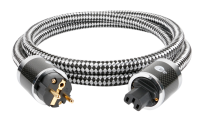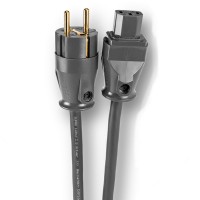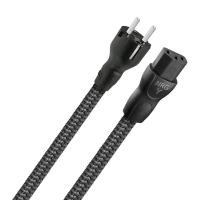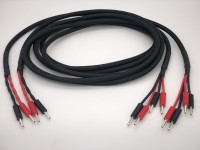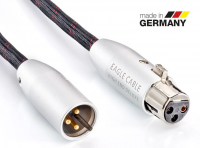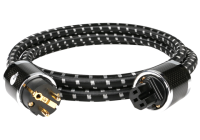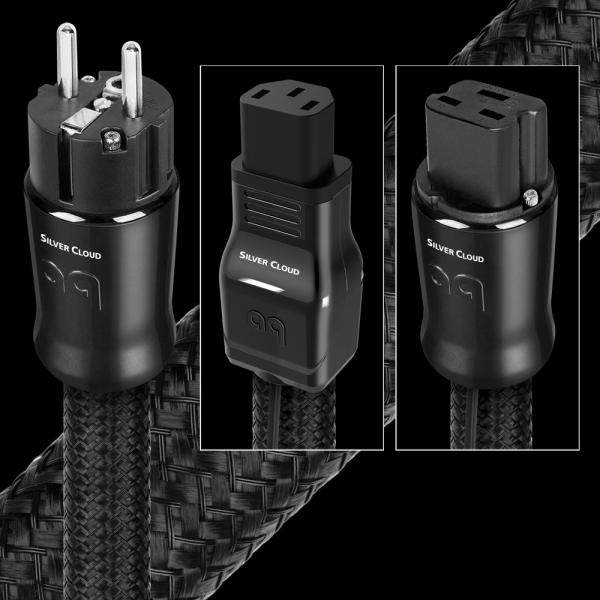
- Artikel-Nr.: JH-28004
Audioquest Silver Cloud XTRM
Silver Cloud XTRM uses many of the same ingredients and technologies found in Silver Cloud—a carefully finessed combination of Perfect-Surface Silver (PSS) and Perfect-Surface Copper+ (PSC+) Conductors, RF/ND-Tech, and ZERO-Tech—but surpasses its namesake model with our best AC plugs, featuring Hanging-Silver over Red and Beryllium Coppers, for lower distortion and improved dissipation of high-frequency noise.
High-Purity True-Concentric Perfect-Surface Silver and Perfect-Surface Copper+ Conductors
Superior metal and conductor geometry greatly reduce ear-fatiguing Transient Intermodulation (TIM) Distortion. Silver Cloud uses a carefully finessed combination of Perfect-Surface Silver (PSS) and Perfect-Surface Copper+ (PSC+).
Uncompressed Current Transfer
While many AC power cables feature low DC resistance in order to accommodate the demand for high current, a cable’s characteristic impedance is also crucial for optimal performance. Unlike most AC cables that constrict or compress an audio-provoked transient, AudioQuest AC cables combine low DC resistance and ZERO (no) characteristic impedance in order to deliver uncompressed high-current transients on demand.
RF/ND-Tech (Patented Radio-Frequency Ground-Noise Dissipation) Minimizes Circuit Misbehavior by Cancelling Induced RF Noise
Though a cable’s ground leads are integral to a component’s signal transmission, they also act as an antenna. Thus, they are subject to induced Radio-Frequency (RF) noise. RF noise is a parasitic signal that is typically coupled directly into a system’s most sensitive audio/video circuits. AudioQuest’s RF-on-ground Noise-Dissipation (RF/ND-Tech) greatly reduces resulting distortion and signal masking, yielding unprecedented levels of Noise-Dissipation across the widest bandwidth (range) of radio frequencies possible. Our unique circuit topology uses a common-mode phase-cancelling array, providing linear noise dissipation across the entire length of the cable (US Patent # 8,988,168).
Wind XTRM Plugs: Cold-Welded Hanging-Silver over Red and Beryllium Coppers
Directionality
All drawn metal strands or conductors have a non-symmetrical, and therefore directional, grain structure. AudioQuest controls the resulting RF impedance variation so that noise is drained away from where it will cause distortion. The correct direction is determined by listening to every batch of metal conductors used in every AudioQuest audio cable. When applicable, arrows are clearly marked on the connectors to ensure superior sound quality. For most models of AQ cable, the arrows not only indicate the direction that optimizes metal-directionality as part of Noise-Dissipation, but also indicates non-symmetrical attachment of shield and GND in order to optimize full-system performance.
Das Unternehmen Audioquest wurde im Jahr 1980 von William E. Low in einer Garage gegründet. Kaum vorstellbar, denn heute gehört Audioquest zu einer der weltweit berühmtesten Kabelhersteller. Der Erfolg in Deutschland setzte aber erst im Jahr 2003 richtig ein. Nachdem die Distribution von Audioquest erst über Marantz und später über Screen Professional erfolgte. Doch was ist das besondere an diesem Kabelhersteller?
Der Gründer William Löw und seine kompetenten Ingenieure haben die Lötverbindung an der Verbindung Stecker/Kabel als einen Schwachpunkt entdeckt. Als Konsequenz daraus, entschied sich das Unternehmen eine eigene Lötlegierung zu entwickeln. Ein spezielles Lötverfahren stellt nun sicher, dass auf der gesamten Frequenzbandbreite kein geringer Zwischenton verloren geht oder verfälscht wird. Für die Signalleiter verwendet Audioquest ein selbstentwickeltes Kupfer, mit einer längs zur Signalaufrichtung geordneten Molekularstruktur.
Diese Neuheiten haben sich besonders im Bereich der tieffrequenz-strapazierten Subwooferkabel bewährt. Besonders Musikliebhaber in den USA und in England wissen diese hohe Qualität zu schätzen und können sich keinen anderen Hersteller in diesem Bereich mehr vorstellen.









